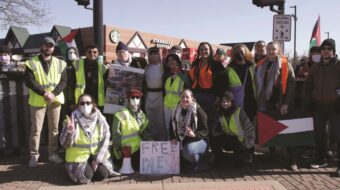Opinion
For weeks before the U.S.-led attack on Iraq, anti-war demonstrators from all over the Bay Area promised that if the United States attacked Iraq there would be “No business as usual in San Francisco.” March 20, the day after Iraq was attacked, thousands poured into the streets to make good on their promise.
As I pulled into San Francisco I was directed to the outskirts of town by a police officer but was soon stopped by a “die-in” in the street. Eventually I was able to get onto a side street and park in a taxi zone without drawing one breath of apprehension; for I knew that there were no tow trucks coming on this day.
Walking on the streets of San Francisco on March 20 felt like walking into a great battle that had yet to be recorded into history. The streets were sporadically scattered with people. From above, they must have appeared like ants that had been disturbed by some giant footprint: confused and disorganized, going in all different directions.
Early protesters chained themselves around financial institutions such as banks. The only saws that were big enough to cut the chains off of these demonstrators belonged to the fire department. However, the fire department could not get to the scene due to the protesters performing “die-ins” in the streets. Eventually the “dead” protesters were moved, but thousands more would soon take their place.
The police department’s early strategy was to arrest those who refused to move out of the street and then line up shoulder to shoulder to block more protesters from getting into the street. However, this also dramatically held back traffic.
The newspapers talked about the destruction that had occurred, the graffiti, the broken windows, and garbage cans that were thrown in the street, but none talked about how the crowd booed when a bottle was thrown at police. Or about the protesters who picked the broken bottle up piece by piece off of the street. The papers also did not give fair coverage of the police brutality that occurred.
There were some protesters who had decided to be violent, and a vast majority of police conducted themselves very peacefully and professionally. However, as the day went on many police just seemed to be frustrated that no matter how many people they arrested there were always more who were ready to take their place. The police stopped trying to arrest everyone in the street and simply started pushing all protesters onto the sidewalks. At one point a young girl was pushed onto an already overcrowded sidewalk by police. The crowd naturally pushed back, and the girl fell into the police line. The police took this as an assault and proceeded to beat the girl repeatedly with their batons. When her friend tried to pull her away she, too, was excessively beaten. As they lay screaming in pain, police stepped on their faces to prevent them from struggling while they were arrested.
This was not unusual treatment for those who broke the police line, but many willingly broke it to show their level of dissent about their government’s actions abroad as well as at home.
Hoping to not get beaten with batons I waited until the police in front of me were busy looking elsewhere before I jumped over police lines. When I did take the “leap of faith,” I was shoved in the back of my head and pushed back into the crowd. Keeping my hands in the air, so as to not give the police any excuses to beat me, I jumped back into the street and sat down. I was told to move and did not, so I was promptly arrested.
After a long ride and some very charming words spoken, both by the police and by my fellow protesters, we arrived at a very large warehouse. Here we received loud applause by hundreds of fellow protesters, many of whom had been there since the early morning.
In the first few days of the attack on Iraq the United States arrested around 1,800 prisoners of war in Iraq. In those same days more than 2,000 people were arrested in San Francisco alone.
Teddy Wood is a student in Santa Cruz, Calif. He can be reached at Scsk8er35@cs.com











Comments